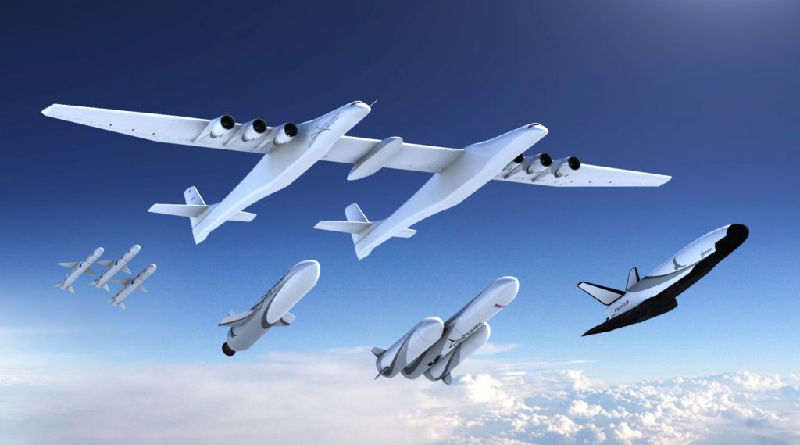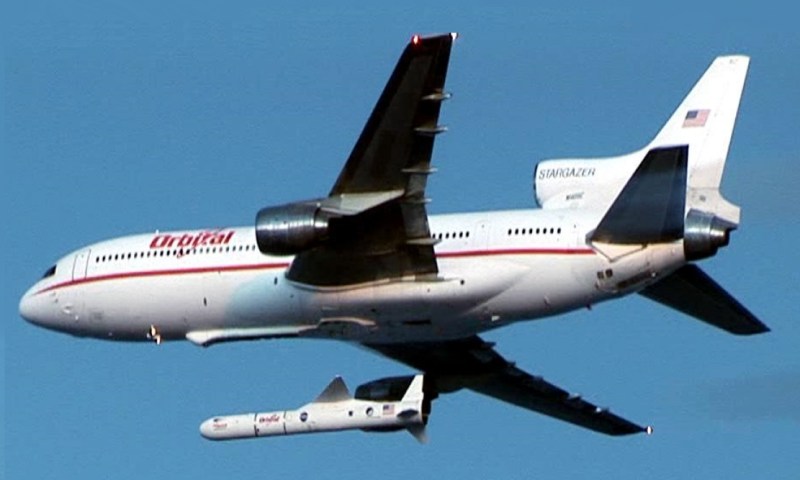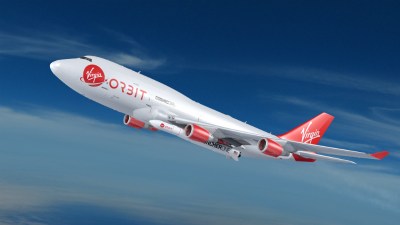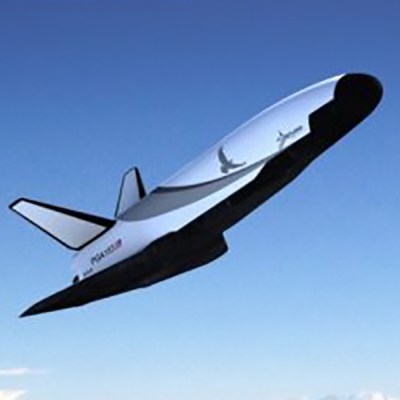Deep in the mojave, the largest aircraft ever made will soon be making test flights. This is the Stratolaunch, and it’s measured the largest to ever fly based on wingspan. The Stratolaunch was constructed out of two 747s, and is designed for a single purpose: as a mobile launch platform for orbital rockets.
There are a couple of ways to measure the size of an aircraft. The AN-225 Mriya has the highest payload capacity, but only one of those was ever built (though that might change soon). The Spruce Goose was formerly the largest aircraft by wingspan, but it only flew once, and only in ground effect. The Stratolaunch is in another category entirely. This is an aircraft that contains some of the largest composite structures on the planet. Not only can you park a school bus between the fuselages of the Stratolaunch, you can strap that school bus to the plane and carry it up to 30,000 feet.
But why build this astonishing aircraft? The reasons go back more than a decade, and the end result is a spaceplane.
The Origin Of The Stratolaunch
The Stratolaunch is the brainchild of two men. The first, Paul Allen, co-founder of Microsoft, has a long, long history of encouraging advances in aviation. He founded the Flying Heritage & Combat Armor Museum at historic Paine Field, Washington, and is perhaps one of the greatest aircraft collections outside the National Air & Space Museum and the Museum of the US Air Force.
The second man behind the Stratolaunch is Burt Rutan, a giant in the aviation world, who wrote several books on composite construction. There are more Rutan designs on display at the National Air & Space Museum than any other aircraft designer.
In 2004, the X Prize Foundation announced the Ansari X Prize, a $10 Million award for the first team to launch a spacecraft carrying two passengers (or a simulation of a human mass) to the edge of space, turn around, and do it again within two weeks. The prize drew its inspiration from the Orteig Prize, which in 1919 challenged aviators to fly across the Atlantic Ocean. Charles Lindbergh claimed the Orteig Prize in 1927.

Allen, with a deep pocket book, and Rutan, with the know-how of how to build such a craft, joined up to create SpaceShipOne, as of right now the only privately-built spacecraft. The success of SpaceShipOne hinged on the unique design of the spacecraft. This was not an airplane that would take off from a runway, light its engine, and blast off into space. Instead, SpaceShipOne would be carried to altitude by WhiteKnightOne, a twin-fuselage carrier aircraft. After separating from its mothership, SpaceShipOne would light its engine and travel on a short suborbital flight to space.
While the SpaceShipOne won the XPrize, and SpaceShipTwo is currently undergoing flight testing, Rutan had been working on a twin-boomed carrier aircraft for decades. The goal is to carry a few hundred thousand pounds to altitude. To accomplish this, Rutan’s twin-boomed design required advances in the state of the art in composites. He couldn’t find a buyer, though, until Allen decided to get back into the space business.
Call it the commercialization of space; with cubesats and SpaceX, there is an ever-growing market for launch vehicles. Allen saw the democratization of the personal computer at Microsoft, with computers moving from massive mainframes to desktop boxes. Maybe the market for satellites would have the same growth curve. Either way, there was money to be made, and an opportunity to build the world’s largest plane. If you were a billionaire and an aviation nerd, what would you do?
Why Stratolaunch Exists

The Stratolaunch is not by any means the first aircraft to haul a rocket up to 30,000 feet. That’s been done before, most notably with the Pegasus rocket. This rocket, developed by Orbital ATK is designed to be air-launched. The reason is simple: air pressure. The engine bells of rocket engines are designed to operate at a specific atmospheric pressure. Elon Musk realized this when he designed the Merlin family of rocket engines. The major difference between the current versions of SpaceX’s engines, the Merlin 1D and the Merlin 1D Vacuum, are the size of the engine bell. At sea level, you want a small engine bell, but in a vacuum, or at least above half the atmosphere, you want a significantly larger bell. Of course, you can get around this problem with aerospikes, but why do that when you can build the world’s largest airplane?
 For this simple reason, Orbital ATK developed the Pegasus rocket, first launched from a B52, then from a Lockheed Tristar. Air launches get above a good portion of the atmosphere, increasing the efficiency of the engine. As an added bonus, planes usually fly above the weather, and since a plane isn’t stationary, you can launch from anywhere on the planet.
For this simple reason, Orbital ATK developed the Pegasus rocket, first launched from a B52, then from a Lockheed Tristar. Air launches get above a good portion of the atmosphere, increasing the efficiency of the engine. As an added bonus, planes usually fly above the weather, and since a plane isn’t stationary, you can launch from anywhere on the planet.
Air-launching a rocket allows for a more efficient engine and you don’t need a to spend the money on a launch pad. On paper, it’s a great idea, but aircraft are only so big. The Lockheed TriStar can carry a phenomenal payload, but mass fractions count, and the Pegasus rocket can only lift a few hundred pounds into orbit.
Richard Branson, the third name attached to SpaceShipOne, is having a go at air-launched rockets with the Launcherone, a slightly modified 747. Virgin Orbit announced they would use Cosmic Girl, an ex-Quantas 747-400 to carry a small rocket to 35,000 feet, which would then carry a 300kg payload into a sun-synchronous orbit. This air-launched rocket scheme uses the fifth engine pylon on the 747, originally designed to ferry engines between airports. It’s a clever idea, but again, you can only lift so much mass with an existing airframe. Take into account the ability to actually fit the rocket to the airplane, and you quickly realize the need for an aircraft specifically designed to lift rockets into the stratosphere.
What The Stratolaunch Will… Launch
The first rocket to be launched via the Stratolaunch carrier aircraft will most assuredly be the Pegasus rocket from Orbital Sciences Corporation. This rocket is able to carry 370 kg to Low Earth Orbit, and has already been flight proven for an air-launch from B-52 and Lockheed L-1011 carrier aircraft.
However, with a new launch platform, there is an opportunity for new launch vehicles. That’s where the Stratolaunch gets interesting, and the company is planning to carry three other rockets.

The planned Medium Launch Vehicle (MLV) will be significantly larger than the Pegasus, and have the ability to carry up to 3,400 kg to Low Earth Orbit. A second variant of this rocket, the MLV – Heavy, uses three cores and will be able to carry 6,000 kg of payload to orbit.
The coolest part of this announcement is, by far, a spaceplane. Like the White Knight Two and SpaceShipTwo, the Stratolaunch is planned to carry a real, orbital spaceplane. This is just a design study for now, but Stratolaunch is planning a fully resuable space plane. The plan is for this space plane to first carry cargo, with manned flights following later on. This space plane will be similar to the super-secret X-37 now currently in orbit, and in fact the company behind the Pegasus family of rockets does have experience with space planes. The Orbital Sciences X-34 was a test program nearly two decades ago, and the design still holds promise.
Will Stratolaunch Get Off The Ground?
Currently, Stratolaunch is busy taxiing around the Mojave, with the first flights due soon, and the first launch of a rocket sometime in 2019. This is the largest aircraft by wingspan ever built, and it was designed in part by the greatest aircraft designer of all time. While it may not have the highest payload of any aircraft, or the greatest takeoff weight, it will stand among the greatest aircraft ever built.
















Tah nice writeup, great to see developments shades of Sky Captain movie, ambitious in respect of 747’s, how they manage structural issues would be of interest, could it lead to pair of 787 fuselages in future given their composite wings rather tougher than 747. How would it go with a Sabre engine such as for Skylon plane to rocket…
https://en.m.wikipedia.org/wiki/SABRE_(rocket_engine)
Would a sabre really be needed since there’s a separate low altitude and high altitude stage? I thought that engine was more for SSTO schemes, to keep one from having to drag around both a rocket and a jet turbine.
You probably could get a decent SSTO using just SSMEs with high altitude air launch since the nozzle can be better optimized for vacuum operation.
> Not only can you park a school bus between the fuselages of the Stratolaunch, you can strap that school bus to the plane and carry it up to 30,000 feet.
> But why build this astonishing aircraft?
If “to drop school buses from 30k feet” is the wrong answer, I don’t want to be right.
> SpaceShipOne, as of right now the only privately-built spacecraft.
The only privately built spacecraft that has made a manned flight to space, maybe. But Dragon is absolutely a privately-built spacecraft..
That depends on how one defines “private” – by who owns and operates the vehicle, or who pays for it and what percentage they pay for.
Dragon development was funded under NASA’s COTS program with flights funded under the CRS program.
We shouldn’t forget Blue Origin, either. Their New Shepard capsule has flown in space (unmanned so far) but like SpaceX some of it’s development (launch escape system and the BE-3 engine) funded under NASA’s Commercial Crew program.
COTS stands for “commercial, off the shelf” FWIW. Now, when NASA was a customer, yeah, customers are what keeps any business, in business.
Subsidies – look to the MIC for those, they even have this EXIM bank to loan their customers money (when no real bank will because it’s obvious they can’t make the payback0…going back before most here were born.
In this case, NASA COTS actually stands for “Commercial Orbital Transportation Services”.
Though you are right commercial off the shelf is normally what it stands for. NASA just can’t make it easy for anyone :)
Heh, Feynman wrote about NASA doing that in his write up of his investigation for the Rogers Commission. So many initialisms, often conflicting with other initialisms, that you couldn’t understand what someone was talking about without carrying around a glossary.
Yes, the confusing irony being that the COTS program was created to fund the development of vehicles in the commercial market because there were no Cheap Off The Shelf options at that time. The COTS program made possible both the Dragon and Cygnus unmanned spacecraft.
What an ugly duckling!
Great article on a system I didn’t realize was in the works even. About time. Now for electromagnetic or steam assisted launching to increase payload or flight duration. Interesting is this type of system has been around for a while using B-52 and for transporting the Space Shuttle even, though the Space Shuttle system was a launch platform. Growing up, I always wondering why we didn’t do the two methods I noted and were still launching from the ground directly? https://en.wikipedia.org/wiki/Drop_test
Coupled with rockets that can re-land now days… and the U.S. will have the most impressive space vehicle launch and recovery by re-landing system again on the planet. Two impressive leaders for sure. Awesome!
I think the tail wing would be connected for more rigid of a structure… though the design of the wing may compensate for added strength via materials or design.
Darn… typo… Lack of caffeinated entry errors all over the place: Mainly replace “…was a launch platform.” with “wasn’t a launch platform.”
Like wasn’t a rocket launch system platform is what I am meaning to clarify since were glide tests and more like cargo plane drops.
yeah, I too wonder why the tails aren’t connected…
I would guess probably because the aerodynamic drag of connecting the tails adds more loss than the extra weight of strengthening the middle wing?
Weight. They don’t need to be connected for structural rigidity and the surface area isn’t needed, so they’re not connected to save weight. The tail booms are plenty stiff enough on their own. This aircraft is never going to do any crazy maneuvers that would heavily load the tail booms to the point the rigidity of the connected tail plane is needed.
Thanks for your replies,
but, just think, if they had connected the tails, it would have reminded people of the P-38!
B^)
Note that, as I understand it, the tail (wing) on most planes does not provide lift. It is for control. Oddly, Rutan used canards on many of his designs, which do provide some lift.
turbulence created by the rockets could disrupt the airflow. no bronco tail
Because it’s unnecessary. Dude’s a bona fide genius airplane designer, he did the math.
I’d like a poster of the article image :D
The only problem with Stratolaunch right now is that they don’t have anything to launch and what they have in the books isn’t actually all that attractive compared to the competition. Scott Manley made a great video about the problem: https://youtu.be/yw84qJIGZeo
>Elon Musk realized this when he designed the Merlin family of rocket engines.
Elon Musk didn’t design the Merlin family of rocket engines, nor did SpaceX really come up with an privately developed rocket engine. The basic design of the engine was drawn up before the moon flights by Northrop-Grumman for use in missiles, given to NASA, which then gave it to SpaceX. SpaceX added an upgraded turbopump they contracted from Barber-Nichols which also had a history with and a portfolio of old NASA rocket tech.
And, if anyone can be really credited, it’s Tom Mueller who’s leading the rocket development team, not Elon Musk.
Tom Mueller doesn’t get the credit he deserves before joining Spacex he designed engines for TRW and worked on the TR-107 and the LCPE without him there probably would be no Spacex.
No, Elon musk totally designed it himself. And built it with his bare hands and no power-tools.
You can tell, because the man can call a hero a pedo and get away with it.
He might have used power tools while no one is looking but that’s OK. He did all these while also coming up with a revolutionary new mode of transportation. If cost, safety and feasibility did not matter so much, would have been awesome.
“No, Elon musk totally designed it himself. And built it with his bare hands and no power-tools.”
In a cave! With a box of scraps!
“…and it was designed in part by the greatest aircraft designer of all time.”
Kelly Johnson?
Good Answer!
+71
I realise now why Branson was extra pissed that BA or Air France wouldn’t sell him any Concordes…. he probably wasn’t all about the prestige supersonic route, as much as he was thinking about an extra 1000mph delta vee at the top of a ballistic climb…
The Concord can also fly much higher then most subsonic aircraft about 60,000 ft vs 43,000 ft.
“The Stratolaunch is not by any means the first aircraft to haul a rocket up to 30,000 feet. That’s been done before, most notably with the Pegasus rocket.”
I think even more notably were the X-1’s dropped and fired off from a B-29 at over 30,000 feet (back in 1947) as well as the X-15 project which actually took men (one at a time) up into space from an air drop launch from a B-29. I think it is great that this idea that actually worked all those years ago is being updated for future use.
Thanks, I really enjoyed this article.
I just double checked and the X-15 , piloted by Joe Walker, flew to an altitude of 67 miles in 1963 after being launched from a B-29. That was the very first controlled flight into space as the accepted altitude where space begins is 62 miles. (The Karman Line) The X-15 was, of course, a rocket plane.
Also worth squeezing in there are the unmanned D-21, air-launched from A-12’s (M-21’s) to comply with the US’s post-Gary Powers assurances that they would no longer carry out *manned* overflights of communist states. Although its purpose was fairly nefarious, it was an interesting precursor to autonomous air-launched orbital vehicles.
Good point. Sounds similar to the “Buffalo Hunters” flown in Vietnam in 1970 in an effort to locate the Son Tay POW camp. Those were “autonomous” as well.
Hmm. It does not look like two 747s at all. Big mods?
The parts taken from 747s are the engines, landing gear, and internal stuff like avionics. The airframe is entirely new.
It looks like most of the 747 wings were used, tacked onto the ends…
I hope they kept the lounge! B^)
I wander what you call those things that fighter jets have on the ends of there wings? And then go whoooooshhhhh and then there is a bang.
And when did they start putting them on planes?
Don’t you call them rockets or missiles. I’m not talking about bombs.
So in reality we have been shooting rockets off of planes since W.W.2..
Actually, rockets were fired from plane during WWI. Unguided and sort of point, shoot and pray, but they did it. I think that started around 1915.
https://en.wikipedia.org/wiki/Le_Prieur_rocket
Air to air or air to ground missiles or rockets used for combat are not capable of reaching the velocities needed to put their payload in orbit, so they can’t launch satellites.
When Yuri Gagarin first orbited the Earth, someone may have similarly asked why the Vostok rocket and spacecraft were a big deal when people could already fly in balloons and airplanes.
And I’ll just leave this here too, from the anti-satellite program: https://en.wikipedia.org/wiki/ASM-135_ASAT
38k feet from an F-15.
With a max altitude of 563 km that thing could even take out the ISS.
Oh yeah. Explicitly design to shoot down stuff like that. Which is nuts. Pretty impressive stuff. Have to pull a zoom climb to properly launch it. I wonder if the stratolaunch is capable of that.
It seems counterintuitive, but anti-satellite systems are less challenging in many ways than launching satellites. They don’t need to get their payload to orbital velocities, they just need to fly sub-orbital to an elevation high enough to be in the path of the satellite.
I wonder whether anyone has thought of using helium baloons to lift a rocket to altitude before firing up the rockets. I haven’t done any calculation to see if it would be cost effective but it seems feasible.
Yes they are called rockoons, except I’d use a balloon lofted ram tube to replace the first stage, if the payloads were high g tolerant.
https://en.wikipedia.org/wiki/Rockoon
Gonna try this in Kerbal space program tonight…
Interesting, other than having a very wide (and thin) wingspan there is nothing large about this aircraft, especially when compared to genuinely large aircraft that we’ve had for years.
Really? It will have the largest wingspan of any plane ever flown. It will have the second largest max takeoff weight, second only to the An-225 (1.3M lb vs 1.4M lb). It will be able to carry the single largest payload (both in size and weight) of any airplane ever flown. The An-225 can carry a single payload of 418k lb, where this one can carry a single payload of 550k lb. What isn’t large about it?
What about these:
http://keystoneaviation.com/the-seven-largest-aircraft-ever-built/
I’m not sure the list is accurate, though definitely has notable craft. I’m trying to determine how they rank criteria. The B-52 and others like the larger variant of the B-29 that need some props… pun intended.
you mean “ex-Qantas”